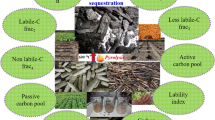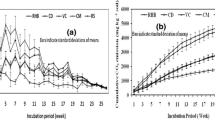Abstract
Only a few have evaluated the mitigation of greenhouse emissions and profit analysis along with soil carbon sequestration for corn cultivation. This experiment was conducted to evaluate the carbon sequestration and mitigation of greenhouse gas emissions as well as their profit analysis with different composts mixed with biochar during corn cultivation. This experimental data provided the second year of corn cultivation. The soil type used was clay loam. The application amounts of synthetic fertilizer and biochar were 220–30–155 kg ha−1 (N–P–K) as the recommended amount after soil analysis and 2600 kg ha−1 based on 1.3% of soil bulk density. For the biannual experimental results, it appeared that carbon sequestration in cow manure cooperated with biochar was highest at 2.3 tons ha−1 and recovered from 67.3 to 78.5% with biochar application. Furthermore, mitigation of CO2-eq. emission as greenhouse gases was estimated to be at 7.3–8.4 MT ha−1, and its profit was evaluated from $7.2 to 8.4 as lowest, from $57.2 to 66.6 as medium and from $139.7 to 162.7 as highest per hectare regardless of organic compost types used. For agricultural practice in Korea, it is evaluated that the market price of CO2 in corn field cooperated with 2600 kg ha−1 of biochar application ranged from $57.2 to 162.7 per hectare in Korean Climate Exchange. For corn biomass, the treatment with biochar application did not significantly decrease compared with the only organic compost application. Based on these experimental results, it might be applied for carbon trading with clean development mechanism for agricultural practices.

Similar content being viewed by others
References
Koocheki A, Nassiri M (2008) Impact of climate change and CO2 concentration on wheat yield in Iran and adaptation strategies. Iran J Field Crops Res 6:139–153
Koocheki A, Nassiri M, Kamali GA, Shahandeh H (2006) Potential impact of climate change on agro-meteorological indicators in Iran. Arid Land Res Manag 20:245–259
Koocheki A, Nassiri M, Soltani A, Sharifi H, Ghorbani R (2006) Effects of climate change on growth criteria and yield of sunflower and chickpea crops in Iran. Clim Res 30:247–253
IPCC (1996) Intergovernmental panel on climate change. In: Climate change 1995: the science of climate change. Cambridge University Press, Cambridge
IPCC (1999) Intergovernmental panel on climate change, data distribution center. CD-ROM version 1.0 In: Providing climate change and related scenarios for impact assessments. Climatic Research Unit, University of East Anglia, April 1999, Norwich, UK
Lal L (2002) Soil carbon dynamics in cropland and rangeland. Environ Pollut 116:353–362
Atkinson CJ, Fitzgerald JD, Hipps NA (2010) Potential mechanisms for achieving agricultural benefits from biochar application to temperate soils: a review. Plant Soil 337:1–18
Laird AD (2008) The charcoal vision: a win-win-win scenario for simultaneously producing bioenergy, permanently sequestering carbon, while improving soil and water quality. Agron J 100:178–184
MIFAFF (2010) Annual statistics in food, agriculture, fisheries and forestry in 2009. Korean Ministry for Food, Agriculture, Fisheries and Forestry
Hammes K, Schmidt M (2009) Changes in biochar in soil. In: Lemann J, Joseph S (eds) Biochar for environmental management. Routledge, Earthscan, pp 169–182
Lehmann J, Rilling MC, Thies J, Masiello CA, Hockaday WC, Crowley D (2011) Biochar effects on soil biota: a review. Soil Biol Biochem 43:1812–1836
Kimble JM, Lal R, Follett RR (2002) Agricultural practices and policy options for carbon sequestration: What we know and where we need to go. In: Kimble JM, Lal R, Follet RF (eds) Agricultural practices and policies for carbon sequestration in soil. Lewis Publishers, New York, p 512
Batjes NH (1996) Total carbon and nitrogen in the soils of the world. Eur J Soil Sci 47:151–163
Shin J, Lee S, Park W, Choi Y, Hong S, Park S (2014) Carbon sequestration in soil cooperated with organic composts and bio-char during corn (Zea mays) cultivation. J Agric Chem Env 3:151–155
EEX (2017) EU Emission Allowances—primary market auction. European Energy Exchange. https://www.eex.com/en/market-data/environmental-markets/auction-market/european-emission-allowances-auction#!/2017/03/06. Accessed 07 Mar 2017
KRX (2017) Korea Allowance Unit. Korean Exchange. http://marketdata.krx.co.kr/mback. http://open.krx.co.kr/contents/OPN/01/01050401/OPN01050401.jsp#document=070301. Accessed 07 Mar 2017
Lehmann J, Kern DC, Glaser B, Woods WI (2003) Amazonian dark earths: origin, properties, management. Kluwer Academic Publishers, The Netherlands, p 505
Lehmann J (2009) Biological carbon sequestration must and can be a win-win approach. Clim Change 97:459–463
Shin J, Choi S, Shin JH (2016) Profit analysis by soil carbon sequestration with different composts and cooperated with Biochar during Corn (Zea mays) Cultivation Periods in Sandy Loam Soil. J Agric Chem Envinor 5:107–113
Collins H (2008) Use of biochar from the pyrolysis of waste organic material as a soil amendment: laboratory and greenhouse analyses. In: A quarterly progress report prepared for the Biochar project
Deenik JL, McClellan T, Uehara M, Antal MJ, Campbell S (2010) Charcol volatile matter content influences plant growth and soil nitrogen transformations. Soil Sci Soc Am J 74:1259–1270
Acknowledgments
We thank to National Institute of Agricultural Sciences, Rural Development Administration beyond Research Program of Agricultural Science & Technology Development for funding the study (Project No. PJ010920).
Author information
Authors and Affiliations
Corresponding author
Rights and permissions
About this article
Cite this article
Shin, J., Hong, S.G., Lee, S. et al. Estimation of soil carbon sequestration and profit analysis on mitigation of CO2-eq. emission in cropland cooperated with compost and biochar. Appl Biol Chem 60, 467–472 (2017). https://doi.org/10.1007/s13765-017-0298-4
Received:
Accepted:
Published:
Issue Date:
DOI: https://doi.org/10.1007/s13765-017-0298-4




